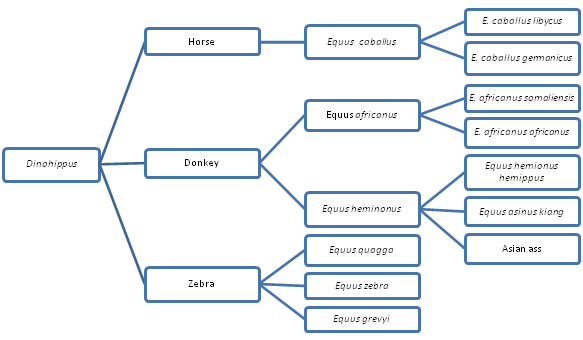A Donkey Is Not Just A Donkey!
Moke,
Ass, Jannet, Jack, Jackass, Burro, Donkey -
So many common names for one species
The following contains more
of
a detailed breakdown in the classification and
explanation of the donkey.
|
 |
Reasoning:
Eukarya
The
donkey can be
classified in this domain
because it is a multicellular
species whose
cells contain a true nucleus
and
membrane bound organelles.
Animalia
This kingdom pertains to
donkeys because they are eukaryotic,
multicellular, heterotrophic, motile, and
lack cell walls. They reproduce sexually and
do not undergo an alternation of
generations.
Chordata:
This species can be classified as
a
chordate because at one point in its life
it has a notochord, a dorsal tubular nerve
chord, pharyngeal pouches, an endostyle, and
a postanal tail.
Mammalia: The
donkey
is considered
a mammal
because it
is homeothermic or
has the ability
regulate temperature internally. Their bodies
are covered in hair and they possess glands
such as sweat, sebaceous, and mammary
glands.
Perissodactyla:
Donkeys are odd toed
ungulates, which means they have an odd
number of toes. This order possess a middle
toe that is larger than all the others.
Other animals in the order
perissodactyla include
rhinos and tapirs.
Equiade:
This is also known as the horse family.
Donkeys are under this family because of
their long heads and necks and possess
a mane. All equids walk on the tips of their
toes. Donkeys are also grazers.
Equus:
Donkeys are classified in
the Equus
genus because
they are
one
toed. Other animals in
this genus include
zebras and horses.
Equus
asinus:
The donkey
has a lean, straight backed body with long
ears and elongated head that helps determine its species.
Equus in Latin means horse. As mentioned previously, there are many different common names for this species. Nowadays, in the United States it is more commonly known as the donkey yet is still referred to as an ass. The origins of the common names are not fully understood. The word ass is believed to come from its species name asinus. In the United States, however, the word ass can be used as a vulgar term. It is believed that the term donkey came from the genetically dominate grey dun coat color.
Phylogenetic Tree
This Phylogenetic tree demonstrates the development of the genus Equus. The evolutionary factors used to develop the tree include morphological differences in the foot, limbs, and teeth. The older organisms possessed four font toes and three hind toes along with smaller pointy teeth. Evolution and natural selection produced the Equus which has a skinnier single toed limbs with larger flatter teeth.

The phylogenetic tree below is a more recent evolutionary tree. Horses, donkeys, and zebras all share the common extinct ancestor Dinohippus. Overtime the Equus genus began evolving into its own species subspecies as seen below.

After understanding the classification of these animals, let's learn about the adaptations they developed.
Copyright © 2007, Design by: Sunlight webdesign